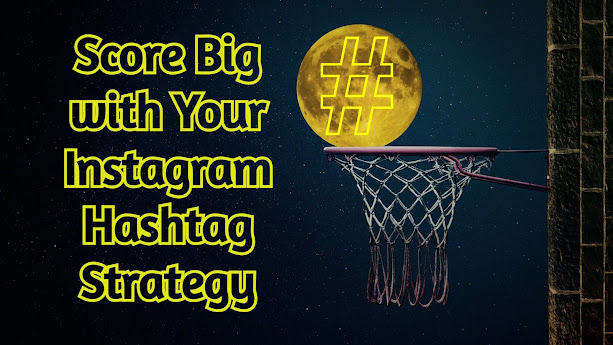Score Big with Your Instagram Hashtag Strategy
Score Big
with Your Instagram Hashtag Strategy
It’s a mistake to underestimate the power of the hashtag on
your Instagram account. Using the right strategy can give your posts some
seriously extended reach and can result in more followers, likes, comments and
even conversions.
The hashtag was born in 2007 on another well-known social
media platform, Twitter, although it wasn’t officially a feature until 2009. A Silicon
Valley blogger and product consultant, Chris Messina, brought up the idea of
repurposing the pound sign for organizational purposes. He even approached
Twitter with the idea and was rejected. It wasn’t until 2 years later that Twitter
gave in and made searching for hashtags a feature, due to their popularity.
The popularity of hashtags made its way to Instagram, and the
platform fully embraced them. According to Wordstream,
posts with hashtags have a 12.6% increase in engagement when compared to posts
without them. If you post often, which is definitely recommended, then this increased
engagement can really add up over time and help you grow your account to meet
your social media goals.
Instagram has 3 places that you can use hashtags:
- Instagram Feed
- IGTV
- Instagram Stories
There are limitations for each of these that are important
to note
Both Feed and IGTV posts have a limit of 30 hashtags. If you
use more than that, then they will not show up in search.
Stories have a limit of 10, however, only the first 3 tags
will show in search.
In hashtag search there are 2 ways to find hashtags: “Top”
and “Recent”
The “Top” tab is based on an algorithm and displays content
based on each individual user’s interests and prior behavior on the app. This
means that every user will see different posts in this tab that are tailored specifically
to them in an effort to create the best possible experience on Instagram.
The “Recent” tab displays posts in chronological order. We’ll
explain why this is important for your strategy later.
Feed & IGTV
The Instagram Feed is where most of the action is. There are
definitely some guidelines to follow to make your Feed posts as effective as
possible, as well as some things you will need to play around with until you
get a winning formula.
There is a divide among experts as to how many hashtags you should
actually use. One camp argues that too many hashtags will leave a bad
impression, as they come off as spammy, and to limit the number of hashtags you
use to a handful of quality tags per post. This argument is made by experts
like Wordstream or Sprout Social.
On the other side, the argument is that using hashtags is
one of the only ways to be found by people who aren’t following you, so why
would you not use as many as possible? Social Media Examiner and Elise Darma
make this argument.
Personally, I fall in the use as many hashtags as possible
camp and here’s why. Instagram will cut your captions short if it they are over
125 characters and add a “more” icon. This makes it really easy to keep your
tags out of sight, making it look less spammy. I’m also not convinced that most
people care how many hashtags you use in your post. It’s also important to keep
in mind that your posts are not guaranteed to show for the tags you put on it,
this is another reason to use as many as possible.
That being said, experiment with using a lot or a few, try
different things, keep track and see which method works better for you!
Another strategy to hide hashtags is to put them in the 1st
comment. Timing is important here. You want to do it quickly so you pop up in
the recent tab. I recommend just putting them in the caption as it saves you
from having to rush to get your tags in there. It’s better to just have them in
there immediately because it really doesn’t make much difference whether they
are in the caption or the 1st comment.
Hashtag Popularity
Ok, now that we got how many hashtags to use and tag
placement out of the way, here is the real strategy when it comes to hashtags.
Not all hashtags are created equal. The cool thing is that
you can look up how popular hashtags are simply by looking them up in the tags
search bar. Instagram will tell you how many posts have been made that have
those tags.
A good strategy is to diversify your hashtag popularity. You
don’t want to put all your eggs in the most popular tag basket because your
content will quickly get drowned out with other content in the “Recent” tab.
It’s really important to use tags that are relevant. Using
really popular tags just to increase reach is a bad idea, not only because it
will get drowned out with other content rapidly, but also because people typed
in that tag to see relevant content and if your content isn’t relevant people
won’t engage with it and may even flag it.
Do your hashtag research and come up with a few in each of these categories:
- Very Popular – 500,000 to 1 Million posts
- Fairly Popular – 100,000 to 500,000 posts
- Niche – Under 100,000 posts
- Branded Hashtags – Tags tied directly to your business
Ideally you want to have multiple lists of relevant hash
tags that have a few of all of these categories. The reason for this is that
Instagram will actually limit your reach if you use the same tags for every
post.
Try using 3-5 very popular tags to see if one sticks. In
reality it is unlikely that the most popular tags will be effective because your
post will quickly be buried in the “Recent” tab and will only really be
viewable for a very short amount of time. However, with high quality content
and a bit of luck, this might end up getting you an incredible amount of
engagement.
Try using 4-10 fairly popular tags as these will remain in
the “Recent” tab for longer and still have a broad audience. These are
generally going to be more effective than very popular tags simply because they
will stick around longer for people to see, but they too will get buried after
some time.
Try using 5-12 niche tags. These are going to be your heavy
hitters. They will stay around in the “Recent” tab for a good amount of time
and are specific enough to where those that are looking for them have a higher
chance of being interested and a higher chance of engaging with your post.
These are also the tags that are most likely to be featured on the “Top” tab,
which I’ll cover in a bit.
Try using 1-3 branded tags. Branded tags are generally not
about new people finding you, at least not immediately. They’re more about
encouraging your current followers to use them in order to increase awareness
of your brand, create community with your followers and personalize/ humanize
your online presence. Coca Cola’s #ShareACoke campaign is a good example.
Finding Hashtags to Use
Ok, now what specific hashtags should you use? That’s really
going to be industry and brand specific, but there are some good ways to find
quality hashtags that fit in your popularity tiers. I would start with checking
out the tags your competitors are using. This might give you good hashtag ideas
and it’ll give you insights into your competitor’s hashtag strategy.
Checking out what Instagram auto fills in the tag search is
another good way to see what might pop up. You can also use a service like Later to get deep into hashtags. The 2 most
important things to consider when deciding which hashtags to use are relevancy
and audience. Relevancy is pretty straight forward to nail down.
Audience, on the other hand, is not something a lot of
businesses take into account for their Instagram hashtags. You want to think of
what people who may be interested in your content are searching for. A lot of
businesses forget that other people may not know as much as they do about their
product or service and use tags that only people who know a lot about it would
know, i.e., your competitors.
Getting Featured on Top Posts
Getting featured in the Top posts for a hashtag can be great
for reach! Getting featured is based on 2 factors: how much engagement your
post received and how quickly it received it.
Instagram’s algorithm is more likely to think you have
quality and engaging content if it receives a lot of engagement in a short
amount of time. This means that it is important for your existing followers to
engage and for your hashtags to do well in search. Remember, high quality
content is king.
Insights Feature
Use the view insights tool to see how effective your
hashtags are. Keep track of which hashtags are repeatedly performing well for
you. With each post, your list of highly effective tags will grow and your
reach will expand because of it. Keep your hashtags organized and categorize
them, so that when you post it is easy to tell which tag categories are
performing and which are not.
The insights tool will show you the top 5 hashtags for each
post, keep track of these. Tags that aren’t on the top 5 might still be getting
you impressions, so keep track for multiple posts. Eventually you’ll notice
which tags are not showing in the top 5 for any post. Try replacing them with
other relevant tags.
Using hashtags for IGTV is very similar to feed. The main
difference between these features is that IGTV is specifically for videos that
are over 1 minute in length and it will show as a large square with the IGTV
logo in search. If you have a working strategy for Feed posts, the same
strategy would probably work for IGTV posts.
Stories
Stories have been a huge success for Instagram, making them an effective way to reach people. A couple things to remember about stories:
- A story only lasts for 24 hours
- There are only 2 possibilities for adding hashtags to your story; stickers or a text box.
Because a story only lasts for a day, instead of focusing on
your fairly popular and niche tags, you’ll want to go BIG. Choose very popular
tags to add so that as many people possible are in a position to see you story.
If you decide to go with a sticker for your hashtag, then
you are limited to a single tag. If you decide to go with a text box, then you
can put a max of 10 tags in there, but keep in mind that only the first 3 tags
will show on search, so might as well just keep it to 3.
People started trying to disguise their hashtags in stories
by decreasing font size and using color to camouflage them. Instagram quickly
became wise to this and now this will result in your tags becoming
nonfunctional. So just keep them legible and you should be alright.
Conclusion
Hashtags have the potential to make a big difference in the
amount of engagement your Instagram posts receive. Besides your profile name,
they are the only way you can be found on the platform. There is a massive amount
of content uploaded to Instagram every day, because of this it’s important to
have a hashtag strategy in place and to analyze and revise your strategy as you
go. Make lists of hashtags beforehand so you don’t rush yourself and so you can
keep track of which tags are performing best for you.
What do you guys think? Anything I forgot or any strategies
you think work better?
How many hashtags do you normally put in your posts?
Direct Placement, LLC is a digital marketing agency that offers a variety of digital ads and services. Our trained and certified team of Account Managers and Internet Marketing Advertisers is dedicated to helping your business achieve its advertising goals. They will work diligently with you to help ensure our advertising efforts are tailored to your specific needs. Contact Direct Placement, LLC today or visit our website to discover how we can start transforming your business one click at a time! You can also follow us on Facebook, Twitter, or Blogger for more online marketing related content.












Comments
Post a Comment